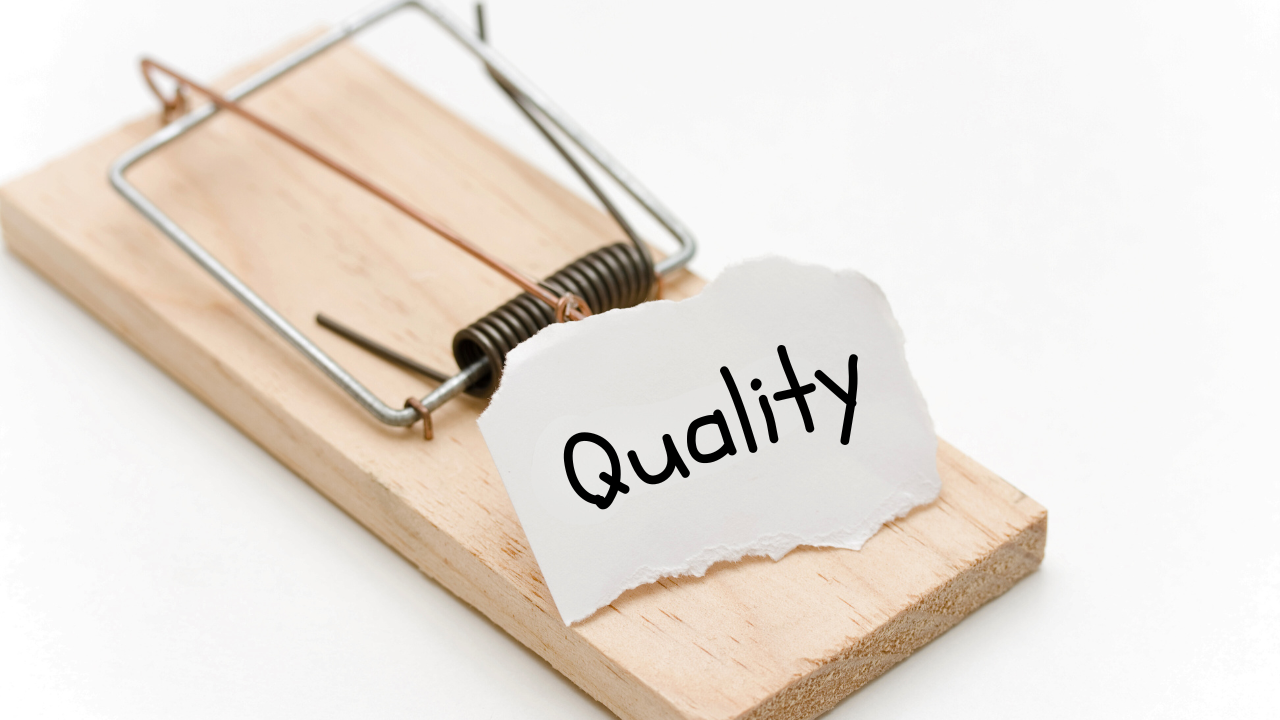What a Quality Trap is and How to Avoid Them

There are value traps, growth traps, and a new category I’d like to introduce the quality trap.
Below I’ll discuss what differentiates a quality trap from value and growth traps and how to identify them.
Value, Growth, & Quality Traps
A value trap is a company that you think is cheap based on the P/E ratio or the P/B ratio but the underlying business is so impaired that you are paying a premium for a business headed to insolvency.
With a growth trap, you know you're paying a premium multiple. You’re paying up for a company with a long-run way for above-average revenue and earnings growth. Whatever multiple you pay today will look extremely cheap in the next 5 years.
But the growth doesn’t come and the market will drastically rerate its multiple lower leading to a large loss for you.
A quality trap is another scenario where you know you're paying a premium market multiple.
Quality companies tend to have consistently high returns on invested capital. Investors are OK with paying a premium multiple because they believe the company has a strong competitive advantage that will allow the company to continue to generate high ROICs. Consistently high ROICs usually lead to long-term above-average earnings growth and significant free cash flow generation that is either reinvested into high-returning opportunities or returned to shareholders through dividends and share buybacks.
A quality trap is a company that looks like a high-quality company with high ROICs and an enduring competitive advantage. But their competitive advantage is deteriorating and their high ROICs are slowly eroding away. This leads to lower-than-expected earnings growth and a lower re-rating of its market multiple leading to investor losses.
From Michael Mauboussin and Dan Callahan’s paper “ROIC and the Investment Process”, companies with declining ROICs produce poor returns over 3 years.

ROIIC
A company’s ROIC declines for several reasons.
The company is investing in sub-optimal projects with lower returns, or worse, in projects that don't cover their cost of capital. There might have been a significant change in corporate strategy regarding capital allocation. The company could be losing its competitive advantage because of disruption, new government regulation, or secular changes in consumer behavior.
Whatever the reason, the decline will present itself in Returns on Incremental Invested Capital (ROIIC).
Return on Incremental Invested Capital (ROIIC) is a measure of the returns a company generates on new capital investments over a certain period. A high ROIIC indicates that a company's new projects are generating returns above their cost of capital, reinforcing its competitive advantage. Conversely, a low or declining ROIIC could suggest the company is succumbing to one of the abovementioned errors.
The Return on Incremental Invested Capital (ROIIC) can be calculated by looking at the change in operating profits over a certain period and dividing it by the total retained capital for the same period2.
To borrow an example, if profits grew by $1B and it took $5B of retained capital to generate that extra $1B, the ROIIC is 20% ($1B/$5B).
One year ROIIC can be lumpy so it helps to also look at a company’s 3 & 5-year incremental returns on invested capital and compare returns with goodwill and excluding goodwill.
Below is the ROIC and ROIIC for S&P Global (SPGI) a consensus high-quality company.

Its consistently high ROICs confirm its high-quality status and its high ROIICs mean the company has an enduring competitive advantage that allows it to reinvest excess capital back into high-returning opportunities.
Direction of Gross Margins
Gross profit margin demonstrates competitive advantage: it is the purest expression of customer valuation of a product, clearly implying the premium buyers assign to a seller for having fashioned raw materials into a finished item and branding it.
Quality Investing
Another factor to look at is the company’s gross margins. Are they expanding, stable, or shrinking?
Gross profit margins that are higher than industry peers and stable indicate a competitive advantage.
Sustained expansion is also a signal of strength, whereas; declining gross margins indicate the company has lost control over a major cost input. Declining gross margins mean less gross profit to reinvest in R&D or advertising to grow the business and strengthen the company’s competitive position.
Direction of Competitive Advantage
It isn’t about the size of the competitive advantage. It’s really about what direction that competitive advantage is heading in.
Paul Black from What Got You There with Sean Delaney
This is mostly a qualitative exercise. Both ROIIC and Gross Margins can tip you off about changes in a business’s competitive advantage but you have to examine and understand what creates and what sustains their competitive advantage.
Does the company have strong network effects, a structural cost advantage, an insurmountable barrier to entry for competitors, or high switching costs that make it very unlikely that customers will switch to a competitor?
Eagle Point Capital recently listed several moat-widening factors along with an example of each one at work.
Investing in Proven Winners
It is easy to fool yourself into thinking a short-term cyclical advantage is an enduring secular competitive advantage. Or a new fad is the start of a new secular trend. Everyone would love to be an early investor in the next big thing. Major fortunes have been made this way.
But these early investors are the exception, not the norm. It’s like lottery winners. We only hear about lottery winners who won it big, not the losers. And we don’t hear about the people who waste too much of their money chasing their lottery dream.
When you try to invest in the next big thing before everyone else does you will inevitably get caught up in a lot of quality and growth traps.
The beauty of quality investing is you don’t have to discover the next big thing before everyone else does. You can invest in companies that are already proven winners. Companies with enduring competitive advantages that allow a company to consistently generate high returns on invested capital should lead to above-average long-term growth and strong shareholder returns. As long as you pay a reasonable price for them.




